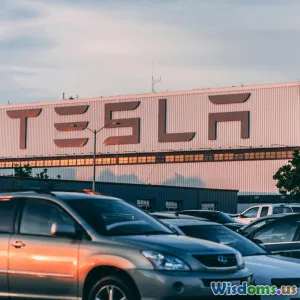
The Impact of 5G Technology on Connected Car Features
8 min read Explore how 5G revolutionizes connected car features, enhancing safety, autonomy, and in-car experiences through lightning-fast communication. (0 Reviews)
The Impact of 5G Technology on Connected Car Features
Introduction
Imagine a world where your car seamlessly communicates with everything around it—other vehicles, traffic infrastructure, and even pedestrians—to deliver unparalleled safety, convenience, and entertainment. This vision is rapidly becoming reality, thanks to the groundbreaking potential of 5G technology. As the fifth generation of wireless communication networks, 5G offers unprecedented speed, ultra-low latency, and massive connectivity capacity. These attributes vastly expand what connected cars can do, driving a transformation in automotive technology and user experience.
In this article, we delve deep into how 5G technology is reshaping connected car features, enhancing autonomy, safety, data capabilities, and much more. From real-world deployments to cutting-edge research, we'll explore the innovations that are powering the next generation of vehicles.
Breaking down 5G: What Makes It Special for Connected Cars?
Before examining the direct impact, it’s crucial to understand why 5G is a game-changer for the automotive industry. Compared to its predecessors (3G, 4G LTE):
- Speed: 5G networks can deliver peak download speeds exceeding 10 Gbps, a hundred times faster than 4G on average.
- Latency: The network delay plunges to around 1 millisecond, enabling near-instantaneous communication.
- Capacity: 5G supports up to a million devices per square kilometer, making it ideal for dense urban environments packed with connected vehicles and IoT devices.
These capabilities allow vehicles to communicate vast amounts of real-time data, execute complex computations on cloud servers, and interact with external systems in ways that were previously impossible.
Enhanced Safety Through Vehicle-to-Everything (V2X) Communication
Reliable Vehicle-to-Vehicle (V2V) and Vehicle-to-Infrastructure (V2I) Links
Safety is a foremost priority for connected cars, and 5G drastically improves how vehicles share critical data. Through Vehicle-to-Everything (V2X) communication—encompassing V2V, V2I, Vehicle-to-Pedestrian (V2P), and Vehicle-to-Network (V2N)—5G enables vehicles to broadcast hazards, traffic conditions, and positional information in real time.
For example, imagine an oncoming vehicle encountering black ice and instantly relaying a hazard alert to surrounding cars, warning drivers to reduce speed. This instant, cooperative awareness can help prevent collisions and reduce accident rates significantly. Qualcomm’s rollouts in pilot cities demonstrate these capabilities, noting potential accident reductions of up to 60% where V2X is actively deployed.
Low Latency: The Key to Real-Time Response
The ultra-low latency of 5G ensures that safety-critical messages arrive almost instantaneously. Earlier cellular networks struggled to meet the sub-10ms latency thresholds required for split-second decision-making. 5G breaches these barriers, allowing vehicles to respond to sudden hazards or pedestrian movements without delay. Nissan, for instance, has tested 5G-based V2X systems that cut warning time by 50%, providing vital seconds for evasive maneuvers.
Accelerating Autonomous Driving
High-Bandwidth Data for Sensor Fusion and AI
Connected autonomous vehicles rely heavily on sensors—LiDAR, radar, cameras—and processing power to “understand” their environment. These sensors generate huge data streams; for example, a single autonomous vehicle can produce terabytes of data every day. Transferring, offloading, or sharing this data demands fast, reliable networks.
Through 5G, cars can leverage edge computing to offload computational tasks to nearby data centers rather than depending solely on onboard processing. This decreases system costs and improves capability. According to Ericsson, 5G combined with Multi-access Edge Computing (MEC) can reduce processing latency from hundreds of milliseconds down to single-digit milliseconds, empowering safer and more efficient autonomous navigation.
Enhanced Cooperative Driving
Autonomous functions will also benefit greatly from platooning, where multiple vehicles coordinate to travel closely together. 5G’s reliability enables synchronized acceleration, braking, and lane changes among platooned vehicles, maximizing road capacity and fuel efficiency. Trials in Europe by companies like Volvo and Scania show platoons reducing fuel consumption by up to 20% and increasing highway throughput by 30%.
Transforming In-Car Experiences with 5G
High-Definition Streaming and Cloud Gaming
Beyond safety and autonomy, 5G profoundly affects occupants’ in-car multimedia and connectivity. With immense data speeds, passengers can stream 4K or even 8K video without buffering. This capability elevates entertainment during long journeys, turning cars into mobile media hubs.
Cloud gaming services, which require high-speed, low-latency connections, will also flourish inside connected cars. NVIDIA is actively collaborating with automakers to integrate cloud-streamed games into infotainment systems, offering users interactive entertainment opportunities usually restricted to PCs or consoles.
Real-Time Navigation and Augmented Reality
5G boosts map data updates and supports real-time routing based on traffic, weather, and accidents. AR heads-up displays that project navigation info or hazard alerts on the windshield depend on low latency and reliable connectivity that 5G enables. For example, WayRay’s AR systems showcase enhanced driver situational awareness through 5G-assisted overlays.
Challenges and Considerations
While 5G opens exciting possibilities, implementing it in connected cars presents hurdles:
- Coverage: Widespread 5G network availability, especially in rural or highway locations, is still developing.
- Cost: Upgrading automotive hardware to support 5G, edge computing, and enhanced sensors may increase vehicle prices.
- Security & Privacy: As more data flows over networks, protecting user data and preventing cyberattacks becomes paramount.
Despite these challenges, continuous investment and collaboration among automotive manufacturers, telecom providers, and policymakers accelerate progress.
Conclusion
5G technology is not just the next step in wireless communication; it’s a foundational catalyst transforming connected car features across safety, autonomy, and passenger experience. From near-instantaneous cooperative driving to immersive, cloud-powered infotainment, 5G is steering us toward a smarter, safer, and more connected automotive future.
As global rollouts expand, early adopters of 5G-equipped vehicles will experience the forefront of automotive innovation, while the industry invites ongoing innovation to harness 5G’s full potential. For consumers and manufacturers alike, understanding and embracing 5G’s impact is crucial in navigating the road ahead.
References:
- Qualcomm V2X Pilot Results, 2023
- Ericsson Whitepaper on 5G and Edge Computing, 2023
- European Truck Platooning Challenge, Volvo & Scania Reports, 2022
- WayRay Augmented Reality Display Demonstrations, 2023
- Nissan 5G-Enabled Safety Trials, 2023
Rate the Post
User Reviews
Popular Posts

















